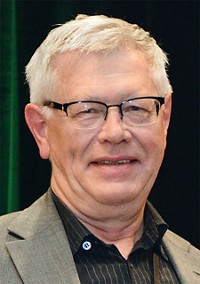Advertisement
Grab your lab coat. Let's get started
Welcome!
Welcome!
Create an account below to get 6 C&EN articles per month, receive newsletters and more - all free.
It seems this is your first time logging in online. Please enter the following information to continue.
As an ACS member you automatically get access to this site. All we need is few more details to create your reading experience.
Not you? Sign in with a different account.
Not you? Sign in with a different account.
ERROR 1
ERROR 1
ERROR 2
ERROR 2
ERROR 2
ERROR 2
ERROR 2
Password and Confirm password must match.
If you have an ACS member number, please enter it here so we can link this account to your membership. (optional)
ERROR 2
ACS values your privacy. By submitting your information, you are gaining access to C&EN and subscribing to our weekly newsletter. We use the information you provide to make your reading experience better, and we will never sell your data to third party members.
Environment
ACS Award For Team Innovation
Recipients are honored for contributions of major significance to chemistry
by Tonia E. Moore
March 2, 2009
| A version of this story appeared in
Volume 87, Issue 9
Sponsored by ACS Corporation Associates
When solving a hard problem, two heads are better than one. That’s the thinking that led engine maker Cummins Inc. to partner with catalyst maker Johnson Matthey several years ago when pondering the design of an aftertreatment system—any device added to an exhaust system to remove pollutants—that would allow a diesel engine to meet the Environmental Protection Agency’s strict 2010 emissions standards.
That unique partnership has led to collaboration among Aleksey Yezerets, Neal W. Currier, and Bradlee J. Stroia of Cummins and Howard S. Hess and Hai-Ying Chen of Johnson Matthey to develop the first NOx adsorber diesel emission control system in the U.S.—which was also the first heavy-duty diesel NOx adsorber system in the world.
The team’s NOx adsorber system was created for trucks on the lighter end of the “heavy-duty diesel” class. It debuted on the 2007 Dodge Ram Heavy Duty pickup, the model lauded by its maker, EPA, and the Department of Energy as the first to meet the 2010 standards.
The breakthrough’s potential to cut emissions and increase fuel efficiency is huge, according to John C. Wall, chief technology officer at Cummins, who was a supervisor on the project. “It paves the way for broader diesel application in pickup trucks, SUVs, and passenger cars,” Wall says. “Diesel substitution for gasoline engines reduces fuel consumption by up to 30%, with proportional reductions in CO2 emissions, but will only be permitted if diesel exhaust emissions are equivalent to gasoline. NOx adsorber technology enables diesel emissions to be controlled to the required level.”
Although dozens of engineers at both companies focused on the task for years, the five-man core group came together to begin sharing data and ideas in 2005, Yezerets says. They brainstormed and communicated daily, jointly planning and conducting experiments and then talking through the results.
The EPA rule’s toughest requirement, they knew, would be reduction of nitrogen oxide by-products of combustion by more than 90%, compared with that achieved by the previous generation of vehicles.
The NOx adsorber catalyst’s main role is to convert oxides of nitrogen (NOx) to nitrogen and water in an overall oxidizing environment. To accomplish this, a catalyst stores NOx during normal engine operation and releases and converts it to nitrogen during short regeneration events. This storage and reduction cycle encompasses five distinct chemical stages, and the adsorber catalyst has to contain all the components required to perform all of these steps, each catalyzing multiple surface reactions.
The processes impose different and often conflicting requirements on the catalytic materials. The components with oxidation/reduction catalytic functions have to be optimized to balance the NO oxidation, NOx reduction, and reductant evolution steps; the NOx storage components must be carefully designed to include dedicated high-capacity for NOx storage and fast response to regeneration. Moreover, the catalytic materials must be minimally affected by sulfur poisoning from the fuel. These two classes of materials have to exist in close proximity to maximize synergy yet minimize negative interactions.
Developing the NOx adsorber catalyst required detailed understanding of the precise mechanisms of its functions; the team had to devise new approaches to study the catalyst’s chemistry.
“Major advances in both engine calibration strategy and engine-catalyst system integration have been made during this project,” says Andrew P. Walker, Johnson Matthey’s heavy-duty diesel global technology director, who was involved in oversight of the project.
Cummins’ Wall doesn’t mince words about how he perceives the scale of the accomplishment either. “It is not an exaggeration to say that this system is the most complex commercial diesel emission control system in history,” he says.
The adsorber is one element in a series of three catalytic components in the exhaust: the close-coupled catalyst, the NOx adsorber, and the particulate filter. Each has different operational and control requirements, the adsorber and filter operate in independent filling and regeneration cycles, and all require transient thermal and chemical management of the exhaust through engine controls.
“Think of it this way,” Currier says. “We are carrying along a small chemical plant. We have to control it and ask the engine to do something very different for the catalyst than it would for normal driving functions without trade-offs in performance. We have to understand the behavior of the catalyst, satisfy its needs, and keep it from deteriorating.”
At the same time, the system has to work regardless of what’s going on behind the wheel. “We had to walk a thin line,” Yezerets says. “You can’t tell the driver, ‘Wait a minute, you can’t brake now—you’re being environmentally friendly!’ ”
Chen, a product development manager in emission control technologies at Johnson Matthey, is responsible for developing advanced emission control catalysts for mobile-source and stationary-source applications. He earned both a B.S. and a Ph.D. in chemistry from Shanghai’s Fudan University in 1989 and 1994, respectively, and did postdoc work at Northwestern University from 1996 to 2000. A member of ACS, he has published more than 40 papers in peer-reviewed journals.
Currier, senior scientist in the catalyst technology and emissions chemistry department at Cummins, has three decades of industrial research experience. Since joining the firm in 1992, he has been in charge of the company’s research portfolio in the area of exhaust emissions reduction catalysis. He has had 23 publications in peer-reviewed journals and given numerous presentations. He received a B.A. in chemistry and mathematics from St. Olaf College, in Minnesota. He is a member of ACS.
Hess, a senior technical program manager in the Emission Control Technologies Division at Johnson Matthey, has worked in the automotive emissions industry for more than 18 years. He earned a bachelor’s in chemical engineering in 1990, a master’s in environmental engineering in 1995, and a Ph.D. in fuel science in 2002, all from Pennsylvania State University. He has published more than a dozen peer-reviewed papers, and he is a member of ACS and of SAE International (formerly the Society of Automotive Engineers).
Stroia, who currently directs the light-duty diesel fuel system team at Cummins, has 19 years of experience as a technical leader in research, design, and development of diesel engine systems. He earned B.S. and M.S. degrees in mechanical engineering/engineering mechanics from Michigan Technological University, in Houghton, in 1984 and 1987, respectively, as well as a Ph.D. in the field in 1989.
Yezerets, who leads Cummins’ catalyst technology and emissions chemistry department, has 15 years of industrial and academic research experience, with environmental and energy-related catalysis as his primary focus. He received M.S. and Ph.D. degrees from Mendeleev University of Chemical Technology, in Moscow, and did postdoc work at Northwestern. He has published more than 30 papers in peer-reviewed journals. He is a member of ACS and has a special appointment to the graduate faculty of Purdue University’s chemical engineering department.
Currier will present the award address before the Division of Industrial & Engineering Chemistry.










Join the conversation
Contact the reporter
Submit a Letter to the Editor for publication
Engage with us on Twitter